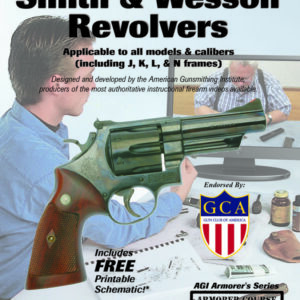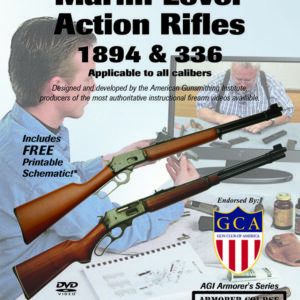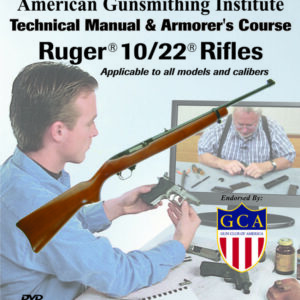Description
Ruger® Standard Auto; Mark I, II, III, & 22/45™
Bob Dunlap is a renowned expert on most of todays and yesterdays important and obscure firearms. He has been a warranty station for most manufacturers, both large and small. He understands the design, function, and repair of firearms in general, and certainly, the gun that got Ruger® off on a successful footing, the Ruger® Standard Auto. We use a cut-away gun to let you actually see how the pistol and all of its components operate. This latest version of the course covers the new Mark II™I and the 22/45™ Mark II™I versions of the gun.
If you want the quick course on how to get the Worlds Most Popular .22 Pistol apart, back together, and operating as intended, then this course is for you (if you want the “long course,” look into our basic 108 hour Professional Gunsmith Course.)
Among the items covered are:
History
- Founded by Bill Ruger® and Alexander Sturm in a small rented machine shop in 1949, the Standard Auto was their first production firearm
- Ruger®s innovative design had a stamped two-piece frame that was welded together and much cheaper to produce than a forged and machined frame.
- The gun looked somewhat like the famous Luger pistol and Ruger®s name sounded like it
- The gun was originally priced at ~ $30, a few cents cheaper than the High Standard Duramatic, the former champ of low priced, good quality .22s, and worked and felt better
- Was and is a great value for the money, and is still the top seller of the .22 Semi Auto Pistols
Design & Function
- Straight blow back operating system explained and demonstrated
- Why the bullet is gone from the barrel before the bolt starts back, the idea of Mass vs. Gas
- The springs NOT the thing
- Trigger/disconnector/safety operation explained and demonstrated
- What the stop pin does and does NOT do
- Fire control operation
- Feeding cycle
- What happens when the extractor does not do what it is supposed to (and we do not mean extracting)
- Trigger operation
- Ejector operation
- Magazine function and operation, difference between Mark I & Mark II Mags shown and detailed
- Mark II differences shown, bolt stop and safety hold open, trigger pin retainer, long shanked extractor plunger
Disassembly
- Extensive disassembly, and instructions on how to take apart those parts/assemblies not disassembled, and explanation of why some assemblies are NOT to be disassembled
- Pay particular attention to the magazine catch disassembly
- You get a good look at how the various parts fit together and interact (particularly the springs) after they are removed from the gun and Bob explains things
Cleaning & Lubrication
- AGI cleaning & lubrication methods shown, along with the reasons for their use
- After cleaning, dry with air gun, or in the oven on Warm ~185-200 degrees (metal parts ONLY)
- Lubing the Bob way, and what kind he likes
Reassembly
- Pins, slave and tapered, hook, punches, etc. Helpful tools to help you get this Chinese puzzle back together easier
- How to tighten up a loose upper receiver to lower frame. PROCEED WITH CAUTION!
- How to correct the poorly fitted extractor, putting the squeeze on
- Extractor configuration and rules shown and explained
- How to do a simple, yet effective, trigger job
- Positive and negative sear/hammer engagement explained, and why it is VERY important
- How to make sure that the safety is SAFE, proper fitting of the part
- If you do not understand the preceding three sections completely, get the Trigger Jobs course or take the gun to a qualified, professional gunsmith. Be safe, not sorry!
- Correcting the magazine follower to cure low feeds
- Correcting feed ramp deficiencies
Accessories
- Grips, Bob tells you which he likes
- Magazines, catches, and thumb savers
- Extended bolt stop
- Muzzle brake
- Scope mount
- Magic hammers, sears and triggers for competition
- Springs, are the aftermarket items a good idea?
- Spare parts to keep around
Final Thoughts
If you noticed how often the terms explanation, and demonstration are used, you may be getting some idea of why this course is necessary for any Ruger® Standard Auto owner, or someone who intends to be.




